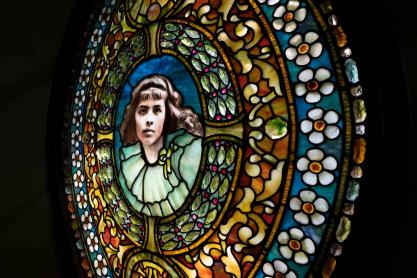“We uncovered a lot of smoke damage,” Zehmer said. “I think you ended up with a combination of both poor lighting and purposely darkened finishes that made this place very dark. And probably part of that played into the Gothic mindset and aesthetic.”
Conservation and restoration specialists from John Canning Co. of Cheshire, Connecticut, worked on the interior woodwork, stripping it down to the original wood and then staining it.
“Conservators evaluated the interior and its original condition,” Hogg said. “They did tests for cleaning the materials; they also did analysis of the building’s original finishes to help us understand what the historic appearance of the building was, because we were pretty sure that it didn’t look like it did when we started the project.”
“This is a nice-sized project for us,” said Ethan Minkema, a conservator for John Canning and Co. “What we’re doing here is relatively simple. We’re cleaning things down to a level where we can start building up the stains again, too. So we’re undoing a lot of previous campaigns after the original, and getting it close to the original conditions, and then building up something approaching the original finish.”
“I would call it surprising just how beautiful the woodwork has turned out to be in this building, because no one would have known,” Hogg said. “Before it was just so dark and so uniform, but there’s a richness to the wood in the ceiling that is really pretty spectacular.”
The new lighting system brings out the wood highlights with LED lights, some aimed toward the ceiling. UVA’s Construction & Renovations Department provided the tradespeople to execute the installation; carpenters and plasterers opened careful raceways for electricians to route wiring for the new lights. They took care to minimize damage to historic fabric, even reusing holes drilled for the building’s original lighting system.
“The care they took during the installation gives the lighting an almost magical quality,” Zehmer said, “and it shows off all the hard work we’ve done to refinish the wood. We hadn’t known that there were a lot of iron fixtures and bolts and rods to help assemble this because they were painted black and they just faded away. With the finish restored, you see this beautiful iron work. That was a pleasant surprise.”
Available Light from Raleigh, North Carolina, partnered with UVA’s Facilities Management Design Services Group to design the new lighting.
Workers removed the approximately 139-year-old pews to the UVA cabinet shop, where they blasted them with baking soda to strip them to the wood, then restored their original light oak finish. Crews also removed carpeting and cork tile flooring underneath – the latter probably installed during renovations in the 1950s – and uncovered the original pine floor.
The restorers had to do their work without historic records of the building.
“It’s not as well-documented as some of the other buildings we have,” Zehmer said. “We don’t have the original drawings. The building was finished in 1890 and five years later, we had the fire at the Rotunda, which was the library, and that’s probably where a lot of our documentation was stored.”
“I hadn’t fully anticipated how powerful the effect of all this work was going to be on this interior,” Hogg said. “It’s really kind of remarkable transformation of the character and the appearance of the building.”










